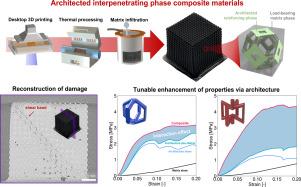Mechanics of micro-architected carbon- and polymer-based interpenetrating phase composites
IF 3.8
3区 工程技术
Q1 MECHANICS
International Journal of Solids and Structures
Pub Date : 2025-09-13
DOI:10.1016/j.ijsolstr.2025.113638
引用次数: 0
Abstract
Composite materials are known for their superior mechanical performance as a result of efficient load transfer between the reinforcing and matrix phases. However, the two-dimensional structure of laminated composites reduces their robustness to shear and out-of-plane loads, also enabling failure mechanisms such as interlaminar failure and fiber pull-out. Meanwhile, unique structure–property relations in architected materials have led to tunable mechanical properties, deformation, and failure mechanisms. While some architected materials have reached near-theoretical limits, the majority of current work focuses on describing the response of an unfilled single-material network, and the effect of a load-bearing second phase to a three-dimensional architecture is not well understood. Here, we develop facile fabrication methods for realizing centimeter-scale polymer- and carbon-based architected interpenetrating phase composites (IPC), consisting of a continuous 3D architecture surrounded by a load-bearing matrix, and determine the effect of geometry and constituent material properties on the mechanics of these architected IPCs. Using experiments together with computational models, we show that the matrix phase distributes stress effectively, resulting in a high-strength, stable response to loading. Notably, failure delocalization enhances energy dissipation of the composite, achieving specific energy absorption values comparable to those of wound fiber tubes. Finally, we demonstrate that the stress state in an IPC can be tuned using geometric design and introduce an example of optimized mechanical response in an architected composite. Altogether, this work bridges the gap between mechanically efficient composites and tunable architected materials, laying the foundation for a new class of strong, resilient, and programmable materials.

微结构碳基和聚合物基互穿相复合材料的力学研究
复合材料以其优异的机械性能而闻名,这是增强相和基体相之间有效载荷传递的结果。然而,层合复合材料的二维结构降低了其对剪切和面外载荷的鲁棒性,也导致了层间破坏和纤维拔出等破坏机制。同时,建筑材料中独特的结构-性能关系导致了可调的力学性能,变形和破坏机制。虽然一些建筑材料已经达到了接近理论的极限,但目前的大部分工作都集中在描述未填充的单材料网络的响应,并且承载第二阶段对三维建筑的影响还没有得到很好的理解。在这里,我们开发了简单的制造方法来实现厘米级聚合物和碳基结构互穿相复合材料(IPC),由一个由承载矩阵包围的连续3D结构组成,并确定几何形状和组成材料特性对这些结构IPC力学的影响。通过实验和计算模型,我们证明了基体相有效地分配应力,从而产生高强度、稳定的加载响应。值得注意的是,失效离域增强了复合材料的能量耗散,达到了与缠绕纤维管相当的比能量吸收值。最后,我们证明了IPC中的应力状态可以通过几何设计来调整,并介绍了一个优化结构复合材料力学响应的例子。总而言之,这项工作弥合了机械高效复合材料和可调建筑材料之间的差距,为新型坚固、有弹性和可编程材料奠定了基础。
本文章由计算机程序翻译,如有差异,请以英文原文为准。
求助全文
约1分钟内获得全文
求助全文
来源期刊
CiteScore
6.70
自引率
8.30%
发文量
405
审稿时长
70 days
期刊介绍:
The International Journal of Solids and Structures has as its objective the publication and dissemination of original research in Mechanics of Solids and Structures as a field of Applied Science and Engineering. It fosters thus the exchange of ideas among workers in different parts of the world and also among workers who emphasize different aspects of the foundations and applications of the field.
Standing as it does at the cross-roads of Materials Science, Life Sciences, Mathematics, Physics and Engineering Design, the Mechanics of Solids and Structures is experiencing considerable growth as a result of recent technological advances. The Journal, by providing an international medium of communication, is encouraging this growth and is encompassing all aspects of the field from the more classical problems of structural analysis to mechanics of solids continually interacting with other media and including fracture, flow, wave propagation, heat transfer, thermal effects in solids, optimum design methods, model analysis, structural topology and numerical techniques. Interest extends to both inorganic and organic solids and structures.

 求助内容:
求助内容: 应助结果提醒方式:
应助结果提醒方式:


